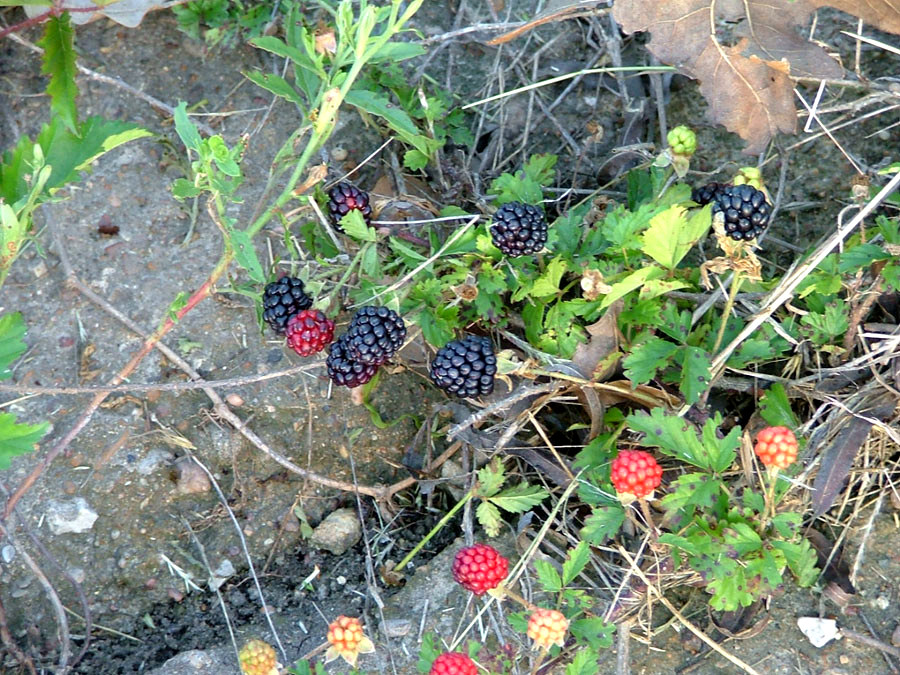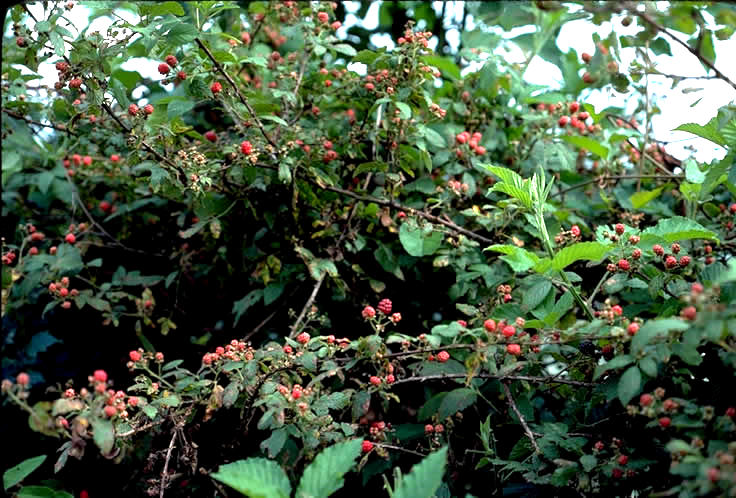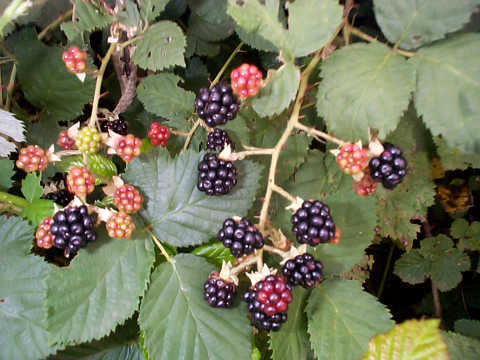Southern Dewberry. Zarzamora, Blackberry
Rubus trivialis Michx. and Rubus spp.
Opuntia spp.
Rosaceae — Rose Family
Southern dewberry is a trailing, low arching, prickle-laden plant that will shred anyone bold or foolish enough to walk through it. It grows in open, disturbed areas along fence lines, roadsides, railroad rights-of-way, and in natural clearings along the coast of Texas, but it is more abundant along the Coastal Bend and upper coast. Dewberry flowers in early spring and provides a tasty black fruit consisting of a cluster of drupelets about half the size of your thumb.
The genus Rubus is large (<250 species) and hybridization and polyploidy (multiple chromosome numbers) makes assigning species problematic. It may be divided, for practical purposes, into two groups, those with red berries and those with black berries. The southern dewberry belongs to the latter group. The fruit of many of these species remains similar, in other words, quite delicious. The predominant species along the Texas coast is Rubus trivialis, southern dewberry, for which there are some ethnobotanical references (Correll and Johnston 1970; Jones 1975).
Archeology. Although no carbonized plant remains have been recovered from coastal prehistoric archeological sites, dewberry occurs abundantly in historic sites. For example, in an archeological study involving the excavation of 19th century homesites in the area of Reliant Stadium in Houston, I found thousands of dewberry seeds in samples collected from the privies. The dewberry brambles had not yet given way to urban sprawl, and Houstonians were picking their own and enjoying that springtime delight. They obviously enjoyed preparing and consuming dewberries, and they left abundant deposits in their outhouses.
Food. Southern dewberry grows throughout southeastern North America up the eastern coast to Maryland. The use of dewberry/blackberry fruit is fairly straightforward – the berries were either eaten raw or cooked into treats or with other food, or they were pressed into a juice. Other parts of the plant were, however, made into a tea. The Cherokee used the berries for making juice and of course ate them raw or cooked with other foods (Hamel and Chiltoskey 1975).
The remaining uses are recorded observations made even farther from Texas, but they serve to highlight the potential uses of the plant by Native Americans in Texas. Many other groups also ate closely related species of blackberry. These include the Chippewa of Minnesota, who ate Allegheny blackberries or collected and dried them for winter use (Gilmore 1913:133). Densmore (1928:321) also notes that the Chippewa cooked blackberries without sugar and flattened and dried them into little cakes on birch bark for storage. The fruit of some other northern species was also consumed or dried for future use by the Menominee, the Ojibwa, and the Meskaki of the upper Midwest (Smith 1923; 1928; 1932). Albert Reagan (1936) chronicled used by the Hoh and Quileute Indians living on the western side of the Olympic Peninsula. They stewed the berries and also ate them raw.
Blackberries were also utilized in southern California/northern Baja where the Diegeno (Kumeyaay) both dried and consumed the fresh berries (Hedges and Beresford 1986). In the Baja, Tipai continue to gather and enjoy blackberry (Weiss 1994:253). The Pomo, with territory just north of San Francisco Bay, consumed the berries fresh or dried them for winter use (Barrett 1952: 83).
Medicine. Dewberries and blackberries also were valued for their medicinal properties. The Cherokee used an infusion of dewberry or blackberry roots/leaves that was taken internally to treat diarrhea and rheumatism. A similar infusion was used as an external wash to treat piles (eg., hemorrhoids). It was combined with honey to prepare a wash for sore throats, and a decoction of leaves was prepared to regulate urination (Hamel and Chiltoskey 1975). A similar preparation was used as a stimulating drink.
A northern species of blackberry, Rubus frondosus was used in conjunction with an unidentified rose-like plant. The scraped inner bark of the blackberry root was placed in a cloth and soaked in warm water, which was then squeezed into the eye, three times a day to treat eye infections. The root of this same blackberry species was used to treat unspecified lung problems and stop the menstrual cycle (Densmore 1928:360). The account lacks details regarding the latter two ailments, but the blackberry root was clearly seen as having useful medicinal properties.
That medicinal properties of blackberry roots were somewhat universal may be seen in the use of blackberry by Midwestern groups. The Ojibwa used blackberry to treat diarrhea (Smith 1932). The Meskwaki used it to treat stomach trouble and sore eyes (Smith 1928). The Objibwa also consumed a decoction of the canes (long, slender, prickle-filled stems) for its diuretic properties (Smith 1932). The Menominee used a decoction of the roots as an eyewash (Smith 1923). In southern California, the Diegueno (Kumeyaay) used a concoction of the roots to treat diarrhea (Hedges and Beresford 1986).
Conclusion. Even though we lack direct observations, the utilization of blackberries or dewberries by the Native Americans of the Texas coast is probably a given. The fruits are delicious and the roots and stem have widespread medicinal applications. Blackberries were, and continue to be, abundant and widespread across most of North America and are enjoyed both fresh and cooked both by American folk today.
References
Barrett, S.A.
1952 Material Aspects of Pomo Culture: Part 1. Bulleting of the Public Museum of the City of Milwaukee 20, Part 1. Milwaukee, Wisconsin.
Correll, D. and M. C. Johnston
1970 Manual of the Vascular Plants of Texas. Contributions from the Texas Research Foundation, Volume 6. Renner, Texas.
Densmore, Francis
1928 Uses of Plants by the Chippewa Indians. Forty-fourth Annual Report of the Bureau of American Ethnology, Smithsonian Institution, Washington, D.C. 1919
Gilmore, Melvin R.
1933 Some Chippewa Uses of Plants. Ann Arbor. University of Michigan Press (p. 133)
Hamel, Paul B. and Mary Chiltoskey
1975 Cherokee Plants and Their Uses: A 400-year History. Herald Publishing Co. Sylva, N.C.
Hedges, M., and C. Beresford
1986 Santa Ysabel Ethnobotany. San Diego Museum of Man -- Ethnic Technology Notes no. 20. San Diego, California.
Jones, Fred B.
1975 Flora of the Texas Coastal Bend. Welder Wildlife Foundation. Sinton, Texas.
Reagan, Albert B.
1936 Plants Used by the Hoh and Quileute Indians. Transactions of the Kansas Academy of Science 37:55-70.
Smith, Huron H.
1923 Ethnobotany of the Menomini Indians. Bulletin of the Public Museum of the City of Milwaukee 4:1-174
1928 Ethnobotany of the Meskwaki Indians. Bulletin of the Public Museum of the City of Milwaukee 4: 175-326.
1932 Ethnobotany of the Ojibwe Indians. Bulletin of the Public Museum of the City of Milwaukee 4:327-525.
Weiss, Audrey Elaine
1994 The Impact of Nutritional Change on the Emergence of Diabetes in Two Tipai Cochimí Communities in Baja California. Unpublished Dissertation. University of California, Irvine. UMI. Ann Arbor, Michigan.



